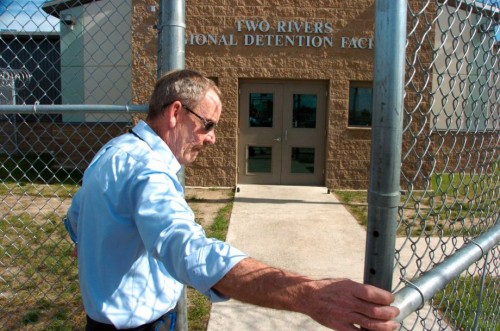
By Matthew Brown, Associated Press
HARDIN, Mont. (AP) — A Montana town that once offered to take in suspected terrorists from Guantanamo Bay out of desperation to fill an empty, $27 million jail has finally started to fill its cells with American Indian inmates from across the Northern Plains.
The Two Rivers Regional Detention Facility in Hardin was built in 2007 on hopes it would boost an economically-depressed area of southeast Montana bordering the Crow Indian Reservation.
But it suffered a series of failures after Montana prison officials said the jail wouldn’t suit their needs. Hardin officials in 2009 sought unsuccessfully to take in Guantanamo Bay, Cuba detainees. They later partnered with a California con-man, Michael Hilton, who promised to turn the jail into a paramilitary training site until his criminal background was revealed by The Associated Press and other news organizations.
Now local officials said they at last have found a legitimate and reliable operator for the 464-bed jail in Emerald Correctional Management, a Louisiana-based private corrections company.
Warden Ken Keller says Two Rivers has taken in almost 60 inmates in recent weeks from American Indian reservations in Montana, Wyoming and North Dakota. Most are serving time for alcohol or drug crimes and must go through an intensive rehabilitation program in Hardin, Keller said.
As Keller showed an Associated Press reporter around the jail this week, guards wearing patches with Emerald’s green logo patrolled the halls.
Inmates clothed in orange were locked into 8- and 24-bed dorm rooms watching television, playing board games and sleeping as they waited for their next therapy session to begin. Others were seen working in the kitchen and being processed in the jail’s intake area.
“Everybody always said it wasn’t going to happen,” Keller said. “It’s happening.”
Yet the latest turn for Two Rivers has raised a new concern for at least one tribal leader: Huge distances separate Hardin from the reservations and will make it difficult for family of inmates to visit.
After the jail’s prior setbacks, Emerald representatives cast a wide net in the search for inmates. They delivered what Hardin had long sought: A contract with a government agency, in this case the U.S. Bureau of Indian Affairs, which should provide a steady flow of inmates potentially for years to come.
For now, all the revenue the jail brings in will go to Emerald and to pay off the $27 million in bonds that paid for its construction. Eventually, Hardin stands to receive 50-cents per inmate, per day, said Jon Matovich, who chairs Hardin’s economic development authority, which owns the jail.
Matovich and other officials said that doesn’t account for the 50 jobs created so far with the jail’s belated opening. That could reach 150 workers if the jail ever reaches full capacity, according to Emerald.
“All the Gitmo and Michael Hilton stuff was kind of a black eye in the way those things turned out, but it’s all good now,” Matovich said.
The BIA is paying Emerald about $70 per inmate per day, said agency spokeswoman Nedra Darling. The drug and alcohol treatment provided by the company is unavailable in BIA-managed jails, Darling said, and inmates are sent to Hardin only with the agreement of tribal leadership.
However, Blackfeet Nation Chairman Harry Barnes said the BIA gave tribal officials only three days’ notice before relocating inmates from an outdated jail on his northwestern Montana reservation to Hardin, 380 miles away.
“They should have consulted us beforehand,” Barnes said. “They showed up on a Friday and said they were going to tear the jail down Monday. …We were only in a position to listen, but we had some concerns with people going all the way to Hardin.”
Barnes said that could present a hardship for family members who want to visit inmates but can’t afford to make the journey. Another source of inmates, the Spirit Lake Tribe of central North Dakota, is located more than 550 miles from Hardin in central North Dakota, an eight-hour trip by car.
Darling did not immediately respond to questions about the BIA’s discussions with the Blackfeet about the jail.
Beyond its agreement with the BIA, Emerald has a separate deal with North Dakota’s Three Affiliated Tribes. Drug and alcohol addiction has spiked in recent years on the reservation near Newtown, North Dakota, fueled by the easy money being generated by an oil boom in the surrounding Bakken region.
“We are in the middle of a heroin and meth epidemic. It’s killing everybody, including our kids,” said Bruce Gillette, who directs a drug treatment program for the Three Affiliated Tribes. “We’ve sent people to other treatment facilities but there are no locked doors so they can literally walk out of get kicked out … From where I’m at, only God could have sent those guys from Hardin to me.”
